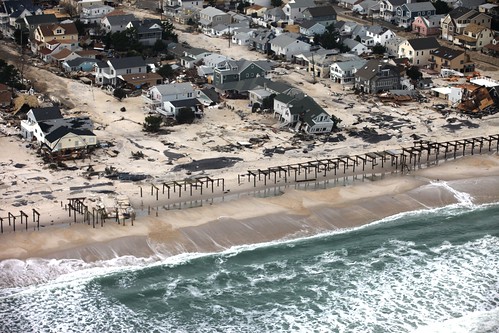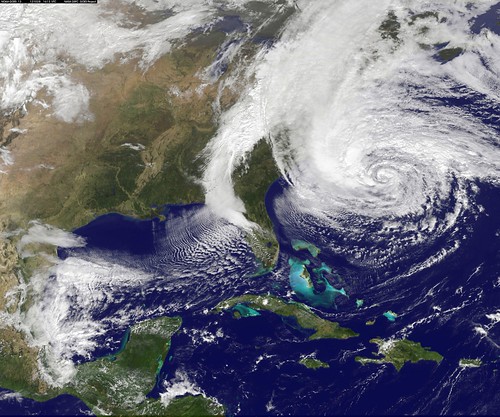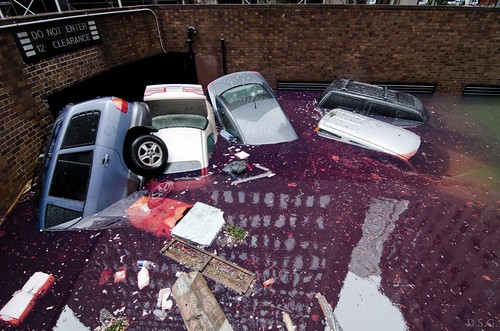Sandy as preview: making communities more resilient to severe climate events (with Lee Epstein)

Posted November 5, 2012 at 5:22PM
(Today’s article is co-authored with my friend and frequent collaborator, Lee Epstein. Lee is an attorney and land use planner working on environmental issues in the mid-Atlantic region.)
Some of us were among the lucky last week as Superstorm Sandy battered, bruised, and killed in community after community in the northeastern US. In fact, both of us were literally out of the country, though Kaid is now back. While we were each pursuing other interests on our respective continents, we reserved some thoughts and wishes for friends, family and colleagues harmed by the storm. It wasn't, and isn't, pretty.
We’re not the only ones to notice that severe weather seems much more commonplace than it did decades ago. Droughts, floods and storms have always been with us, of course, but more intermittent and spotty then than now, or so it sure seems. Scientists say we had best get used to it.
Juliet Eilperin writes in The Washington Post:
“As the Northeast struggles with the aftermath of the massive storm Sandy, many experts say the government for years has underestimated how much of the nation is prone to flooding, given the increasing likelihood of extreme weather because of climate change and the prospect of future sea level rise.
“These experts, who include not only environmentalists but also community planners, insurers and fiscal conservatives, have pressed agencies such as the Federal Emergency Management Agency to rethink the way the government evaluates the risk of floods. Such a change could affect where and how infrastructure is built and make it harder to develop vulnerable areas.”
While even the words “climate change” seem to make some naysayers red in the face, people who worry about vulnerability and costs must be more realistic, in order to prepare. Eilperin quotes New York governor Andrew Cuomo as among the concerned pragmatists:
“Anyone who thinks that there is not a dramatic change in weather patterns is denying reality. We have a new reality, [but] old infrastructures and old systems.”
Rainfall totals that were considered 1-in-100-year events in the 1950s through 1970s had become 1-in-60-year events in the 1980s through 2007. Some scientists say that rain events in the Northeast that are now 1-in-20-year events will take place every four to six years by the end of this century.
(In fact, as we write, forecasters are warning of another big storm -- perhaps not as devastating as Sandy but a nor’easter and big nonetheless -- that could hit the Northeast this week, even as Sandy wrecked or significantly weakened natural and man-made protections (dunes and seawalls) along the East Coast.)
An article posted by Our Amazing Planet on Skye News quotes a USGS report as finding that beaches on the East Coast have been steadily eroding for 150 years. On average, the beaches in New England and the Mid-Atlantic are losing about 1.6 feet per year.
But Sandy has made the current situation worse. For example, the beach on New York City‘s Rockaway peninsula, which we featured here recently in a story about the community’s historic but endangered bungalows, “was almost completely washed away,” according to the article. And there has been much, much more: as we write, Sandy has killed at least 106 people in the United States. Power outages now stand at about 1.4 million homes and businesses, down from a peak of 8.5 million.
Even without violent storms, of course, we have a significantly warmer climate and droughts to deal with. Only four months ago, the US was experiencing its worst drought in over half a century, with a majority of the country classified in moderate-to-severe drought. June 2012 ranked as the third-driest month nationally in 118 years.
As we reported in another story, over the past 50 years our average global temperature has increased at the fastest rate in recorded history. Scientists say that under current trends, average US temperatures could be 3 to 9 degrees higher by the end of the century. While the year-to-year rates of warming have varied and will probably continue to vary, perhaps even with some years of apparent leveling or even slight decreases, few dispute that the overall trend is significantly upward. This affects ocean levels and currents, and wind patterns, in ways that can increase the severity of storms.
Obviously, this requires a plethora of responses, some large and some small. (For some that are community-based, see our story, “Nine low-tech steps for community resilience in a warming climate.”)
The good news, if we can call it that, is that some cities are beginning to get serious about the difficult and politically sensitive issue of climate change adaptation, as warming (or in some cases cooling) temperatures, increasingly violent rain, wind, and ice storms, and accelerating coastal and inland flooding, begin to change the local environment and challenge the health and well being of their citizens. And they are doing so in a way that makes them stronger and more resilient in other ways.
The Louisville Courier-Journal’s James Bruggers, for example, has reported about that city’s efforts. Weather-related disasters over the past four years in the newspaper’s region (four events in Louisville, two in southern Indiana, and eleven in Kentucky) have cost the Federal Emergency Management Agency $700 million in damage reimbursements and mitigation grants. Four years, $700 million. For just one small part of the country. And that doesn’t account for private costs, such as those for higher insurance premiums or non-insured outlays, increased health care costs, higher utility bills, and higher taxes to pay for local or state government responses.
Bruggers’s story describes some of the local responses:
“Whether it’s an example of climate change or just temperamental Mother Nature, the evidence of more extreme weather is mounting in Louisville and across the nation. And city officials and business leaders are taking their first steps to prepare for what some scientists predict could be even dodgier consequences ahead.
“That includes identifying some of the weather threats, ramping up the emergency-response system, buying out some residents of flood-prone areas, introducing green infrastructure such as plant-covered roofs, and launching an effort to cool the city by restoring the vastly depleted tree canopy. And a new, long-range planning effort called Vision Louisville will attempt to factor in climate change, city officials said.
“Much of that work is being done without direct reference to global warming. For example, in announcing his tree initiative, Mayor Greg Fischer cited the need to shrink Louisville’s ‘urban heat island’ — the downtown buildings, roads and parking lots that exacerbate hot conditions in the summer. And many of the Metropolitan Sewer District’s changes are tied to an agreement with the US Environmental Protection Agency to greatly reduce sewage overflows — while also helping handle anticipated heavier storms.”
On a national basis, what are we dealing with here? There are numerous adverse effects on cities and people that we can expect from climate change -- and, to complicate matters, they will take place in different ways and with differing degrees of severity in different places. Some of the possibilities:
- Lower drinking water supplies as reservoirs are challenged by severe drought in some places
- Conversely, additional stormwater, and street and private property flooding from more frequent or more severe storms in other places;
- Coastal flooding from storms and sea level rise, and salt water intrusion into near-coast drinking water sources (Florida is already seeing this in a big way)
- Power outages
- Allergies, asthma, and new pests and disease vectors (such as mosquitoes bearing new diseases for northern climes), as plant and animal communities migrate and natural habitats change – which animal and plant biologists testify is already occurring
- Health effects due to increasing ozone levels, heat stroke, or again conversely, problems with severe cold
- Direct effects on infrastructure – roads, bridges, and utility systems overstressed by weather and temperature
None of these is great to think about, or even to write – but cities can and should prepare for them, and they can and should seek ways to adapt to the "new reality," as governor Cuomo put it. Unfortunately, not all cities will be able to adapt: coastal cities, in particular -- such as many in Florida, sited on reclaimed lowlands or on the edge of wetlands -- face severe challenges. Generally speaking, however, the more sustainable a city’s design and landscape, the better it will be able to handle many of these changes.
So what can cities do? Some cities eventually may need to make the tough choice to actually buy out residences and businesses in the most flood-prone places, and seek to relocate these folks to higher or safer ground in redeveloped or newly developed areas. If done right, this can actually strengthen the community as a whole, adding a bit more development in abandoned, deteriorating or underused property, making new development more walkable and and more readily accessed with multiple intersections and shorter blocks (better for emergency access and egress). But it is necessarily a very, very hard and emotional thing to move established neighborhoods and people.
Fortunately, some of the things that make cities more resilient and able to adapt also make them more livable and sustainable: Localities can take steps to increase walking, biking, and transit as alternatives to automobile usage, for example, through street redesign and capital investments. Cities can reduce their own heat signatures (and cooling costs) by using light, heat-reflective colors on surfaces. They can also add trees from among adaptive species, as well as green space and “green roofs” that double as management practices for dealing with increased stormwater runoff; green roofs also reduce energy costs for the buildings beneath them. Green stormwater infrastructure, which mimics natural systems in promoting slow infiltration and using plants that take up pollutants, can help cities better manage the rainwater runoff from (in some geographies) more frequent storms due to climate change. Such practices can also cool and beautify neighborhoods and thereby provide both social and economic benefits.
Promoting in-town growth and conserving nearby open space, well-managed farms, and forests, can have beneficial micro-climate effects, provide space for population migration in the future if necessary (as an adaptation), help assure cleaner local water resources and the provision of local food and, as noted above, have a salutary effect on lowering locally produced greenhouse gas emissions because of lower rates of driving than would be exacerbated by sprawl.
Finally, local energy use, generation, and efficiency all have a role to play. In general, the less fossil fuel-burning gases that escape into the atmosphere the better, and the lower a city’s energy needs are, the better – especially from such sources. As noted, green roofs and cooler streets and sidewalks due to additional tree canopy can reduce urban heat island effects and local cooling needs, as well as increase energy efficiencies. The local use of renewable energy sources, like solar and wind sources on buildings, is another way to increase environmental performance. (There are also salutary local jobs-producing effects from energy auditing and retrofitting to increase energy efficiency.)
There remain, of course, much more expensive and capital-intensive means for “adapting.” Constructing huge levees and pumping systems around flood-threatened cities is one such method, although such a technique doesn’t work everywhere and is so expensive that it is probably unavailable to all but a very few cases, in these days of shrinking state and local budgets or federal help. But, all in all, there are numerous green techniques and sustainable processes that can assist cities and urban areas both reduce their own heat signatures and adapt to the significant climate change that is happening even as this post is being written. Urban areas should begin planning for and implementing these changes now, before expense or emergency makes them harder to accomplish.
Related posts:
- Nine low-tech steps for community resilience in a warming climate (March 22, 2012)
- How sprawl worsens the impacts of drought and how smart growth can help (July 19, 2012)
- Climate ride rolls strong for clean transportation and a healthy planet (May 24, 2012)
- So, if climate change were a hoax (which it isn't), then what? (July 15, 2011)
- Hey, Copenhagen: climate protection must include smart, walkable neighborhoods (December 14, 2009)
- NOAA launches terrific new web site and report on coastal smart growth (September 14, 2009)
- We must pay more attention to coastal development and sea level rise (January 27, 2009)
Move your cursor over the images for credit information.
Please also visit NRDC’s sustainable communities video channels.



